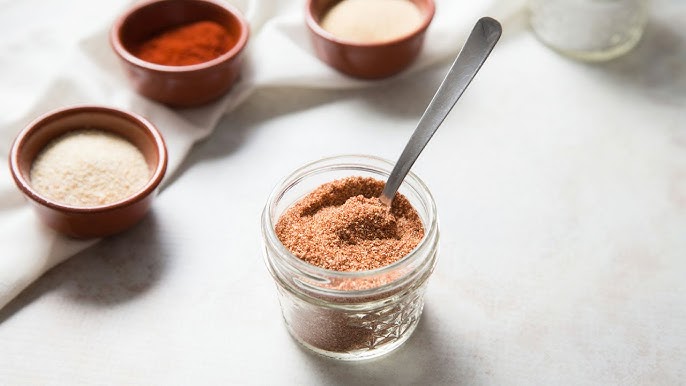Fry Seasoning Recipe: If you’ve ever wondered why restaurant fries taste so addictive, the secret often lies in the seasoning. Fry seasoning is more than just salt sprinkled over hot fries—it’s a flavorful blend of spices that transforms ordinary potatoes into a snack you can’t resist. Whether you prefer crispy French fries, crunchy wedges, or golden air-fried potatoes, a well-balanced seasoning mix is the magic dust that elevates them.
So, why settle for bland fries when you can create your own perfectly balanced seasoning at home? With the right mix, you’ll never go back to plain fries again. In this guide, we’ll walk through the ingredients, the preparation process, tips for success, and even a few exciting variations so you can craft your own signature fry seasoning.
What is Fry Seasoning?
Fry seasoning is a dry spice blend used to coat fries and other snacks, giving them a savory, sometimes spicy, and always delicious flavor. Think of it as the personality of your fries—without it, they might be tasty, but with it, they become unforgettable.
The most basic fry seasoning includes salt, pepper, paprika, and garlic powder, but creative versions often add onion powder, cayenne pepper, or even Parmesan cheese. Unlike dipping sauces that sit on the side, fry seasoning becomes part of the fries, ensuring every bite packs flavor.
One of the best things about making your own is that you control the ingredients. Want more heat? Add chili powder. Prefer smoky flavors? Use smoked paprika. On a low-sodium diet? Adjust the salt to your preference. Homemade fry seasoning isn’t just about flavor—it’s about flexibility.
Why Make Your Own Fry Seasoning?
You might ask, “Why not just buy a pre-made mix from the store?” Here’s the thing—homemade seasoning beats store-bought for several reasons:
- Control Over Ingredients – Store-bought mixes often contain fillers, preservatives, and excessive salt. When you make your own, you choose every ingredient that goes in.
- Custom Flavor – Your taste buds are unique. Homemade seasoning lets you experiment until you find the perfect balance of salty, spicy, smoky, or herby flavors.
- Cost-Effective – Most of the ingredients for fry seasoning are pantry staples. Instead of buying a pricey branded mix, you can whip up a fresh jar anytime.
- Freshness Guaranteed – Spices lose potency over time. By blending your own in small batches, you always have fresh, bold flavor ready.
- Endless Uses – Fry seasoning isn’t just for fries. It works wonders on popcorn, roasted veggies, grilled meats, and even scrambled eggs.
Making your own seasoning feels like discovering a kitchen hack you’ll use forever. It’s simple, rewarding, and elevates everyday comfort food into something restaurant-worthy.
Ingredients You’ll Need
Creating fry seasoning is all about striking the right balance between saltiness, savoriness, and a hint of spice. Here’s a breakdown of essential ingredients you’ll need:
Core Spices for Flavor
- Salt – The foundation of any seasoning. Fine-grain salt works best since it clings to fries.
- Black Pepper – Adds a mild heat and sharpness that balances the salt.
- Paprika – Brings mild sweetness and a hint of smokiness. Regular paprika works well, but smoked paprika adds depth.
- Garlic Powder – Enhances fries with a warm, savory kick.
Optional Ingredients for Customization
- Onion Powder – Pairs perfectly with garlic for deeper flavor.
- Cayenne Pepper – Adds a spicy punch if you like heat.
- Chili Powder – For a Tex-Mex style seasoning.
- Dried Herbs – Such as oregano, thyme, or parsley for an herby touch.
- Parmesan Powder – If you want a cheesy, umami flavor.
Choosing the Right Salt and Pepper
- Kosher Salt vs. Table Salt – Kosher salt is less salty per teaspoon and provides better coverage, while table salt dissolves quickly for even distribution.
- Ground vs. Cracked Pepper – Freshly cracked black pepper gives stronger flavor, while pre-ground is milder and more uniform.
Pro Tip: Start simple with the core spices, then gradually add extras to suit your taste.
Step-by-Step Guide to Making Fry Seasoning
Making your own fry seasoning is surprisingly quick—it only takes a few minutes once you’ve gathered your ingredients. Follow these easy steps:
Step 1 – Gather and Measure Ingredients
Before you begin, gather all the spices. For a small batch, here’s a base recipe:
- 2 tablespoons salt
- 1 tablespoon paprika
- 1 tablespoon garlic powder
- 1 teaspoon black pepper
- ½ teaspoon onion powder (optional)
- ¼ teaspoon cayenne pepper (optional)
Measure carefully—too much salt can overpower the blend, while too little will leave fries tasting flat.
Step 2 – Mix Ingredients Evenly
Place the spices in a small mixing bowl. Use a spoon or whisk to combine them thoroughly. The goal is even distribution so no single spice dominates.
If you want an ultra-smooth blend, you can pulse the mixture in a spice grinder. This helps the seasoning stick better to fries, especially air-fried or baked ones.
Step 3 – Adjust Seasoning to Taste
Taste-testing is key. Dip a fry into the mix or sprinkle a small amount on popcorn to check the flavor balance. Want more smokiness? Add paprika. Too salty? Increase the garlic or onion powder to balance it out.
Step 4 – Store Properly for Freshness
Transfer your fry seasoning into an airtight spice jar or container. Keep it in a cool, dry place away from direct sunlight. When stored properly, the seasoning will stay fresh for up to 6 months.
Tips for Perfect Fry Seasoning
When it comes to fry seasoning, the secret lies not only in the ingredients but also in how you balance and apply them. Anyone can throw salt and pepper on fries, but if you want fries that taste like they came from a gourmet kitchen, a few smart tricks make all the difference.
First, balance is everything. Salt should never overpower the other flavors—it should enhance them. Too much paprika might make the seasoning taste earthy, while too little leaves the mix bland. The key is to find a middle ground where every bite feels complete. Start with small amounts, taste test, and adjust until you find your sweet spot.
Second, texture matters. Using finely ground spices helps the seasoning stick better, especially to hot, crispy fries. If your seasoning blend is too coarse, much of it will fall to the bottom of the plate. That’s why pulsing the mix in a spice grinder can help achieve a smoother consistency.
Another important point is timing. Seasoning fries right after they come out of the oil or air fryer ensures maximum adhesion. The heat releases steam, which helps the spices cling. If you wait until fries cool down, the seasoning will slide off.
Lastly, avoid common mistakes such as over-salting or mixing in wet ingredients. Fry seasoning should always be a dry blend. If you want a cheesy or herby twist, stick to powdered Parmesan or dried herbs, not fresh ones, which can introduce moisture and spoil the mix faster.
By following these tips, you’ll guarantee that every batch of fries you make comes out perfectly seasoned and absolutely irresistible.
Best Ways to Use Fry Seasoning
Sure, the obvious use is sprinkling this blend over French fries, but why stop there? Fry seasoning is a versatile kitchen hack that can transform a wide range of snacks and dishes.
On French Fries
Classic deep-fried French fries are the most popular canvas for fry seasoning. As soon as the fries come out of the oil, toss them in a bowl with your seasoning blend. The hot surface grabs onto the spices, locking in flavor. This works great with thin shoestring fries, crinkle cuts, or thick steak fries.
On Baked or Air-Fried Fries
If you’re skipping the oil and opting for a healthier method, fry seasoning still works beautifully. Coat raw potato slices with a little olive oil, sprinkle the seasoning before baking or air frying, and you’ll end up with flavorful, crispy fries that rival any fast-food chain. This method also works with sweet potato fries, zucchini fries, or even carrot fries.
On Other Snacks and Dishes
Don’t limit yourself to fries. Fry seasoning is amazing on:
- Popcorn – Sprinkle for a savory movie-night upgrade.
- Roasted Vegetables – Toss with broccoli, cauliflower, or Brussels sprouts.
- Scrambled Eggs or Omelets – A dash of fry seasoning instantly elevates breakfast.
- Grilled Chicken or Fish – Use it as a dry rub before cooking.
- Snack Mixes – Add to pretzels or roasted nuts for an addictive flavor.
Once you start experimenting, you’ll realize this isn’t just fry seasoning—it’s a universal spice mix that can take almost any dish from good to great.
Variations of Fry Seasoning
The best part about making your own seasoning blend is how customizable it is. Depending on your mood or the dish you’re pairing it with, you can easily switch things up. Here are some tasty variations to try:
Spicy Cajun Fry Seasoning
For a Southern twist, mix paprika, garlic powder, onion powder, cayenne pepper, and dried oregano. This bold blend delivers heat and complexity, making it perfect for those who love a spicy kick.
Smoky BBQ Fry Seasoning
Blend smoked paprika, brown sugar, chili powder, and a touch of cumin for a smoky-sweet flavor. This variation pairs wonderfully with sweet potato fries or grilled meats.
Garlic Parmesan Fry Seasoning
Combine garlic powder, Parmesan powder, parsley, and a touch of salt. This cheesy, herby mix tastes like something straight out of an Italian restaurant.
Each of these variations takes only a minute to prepare but can completely change the vibe of your fries. Think of them as themed versions for different occasions—game day, summer BBQs, or cozy family dinners.
Pairing Fry Seasoning with Dipping Sauces
While fry seasoning alone can make fries taste incredible, pairing it with the right dip pushes things to the next level. A great dip complements the spice blend, balancing or enhancing its flavors.
Classic Ketchup and Mayo
Sometimes, you can’t beat the classics. Ketchup’s tanginess and mayo’s creamy richness are universal favorites that work with any fry seasoning. Mix the two together for a quick “fry sauce.”
Spicy Dips for Extra Kick
If you’re using a Cajun or chili-based seasoning, spicy dips like sriracha mayo, chipotle aioli, or buffalo sauce are perfect companions. They amplify the heat while adding a creamy texture to cool things down just enough.
Creamy and Cheesy Options
For garlic Parmesan fries, nothing beats ranch dressing, cheese sauce, or garlic aioli. The creaminess balances out the salty, umami notes of the seasoning, creating a rich, indulgent bite.
Pairing dips with your fry seasoning is like choosing the right wine for a meal—it completes the experience and makes the dish unforgettable.
Storing and Shelf Life of Fry Seasoning
A well-made seasoning mix can last a long time if stored properly. Since fry seasoning is a dry blend, moisture is its biggest enemy. To keep it fresh:
- Use Airtight Containers – Small glass jars or spice tins are perfect. Avoid plastic bags, which don’t seal as tightly.
- Store in a Cool, Dark Place – A pantry or spice drawer is best. Avoid keeping it near the stove, where heat and steam can affect flavor.
- Label with Date – Even though spices don’t “spoil” quickly, they lose potency over time. Labeling ensures you know when to refresh your batch.
On average, homemade fry seasoning stays fresh for 4–6 months, but the best flavor comes within the first 2–3 months. If you notice the aroma fading, it’s time to whip up a new batch.
Healthier Alternatives for Fry Seasoning
If you love fries but want to keep things on the healthier side, don’t worry—you don’t have to give up on seasoning. By making a few smart swaps, you can enjoy flavorful fries without excess sodium or additives.
One of the easiest changes is going for a low-sodium version. Instead of using regular table salt, try sea salt flakes or Himalayan pink salt in smaller quantities. They provide a richer taste, so you need less overall. Another trick is to bulk up the blend with herbs and spices that bring strong flavor without added salt. Garlic powder, smoked paprika, oregano, thyme, and rosemary all deliver depth and aroma without raising sodium levels.
For those watching calories, you can also skip sugar-based blends (like BBQ seasoning) and instead lean on herbs and citrus zest. A little lemon or lime zest mixed into your seasoning gives a refreshing kick that pairs beautifully with fries.
You could even experiment with nutritional yeast as a healthier stand-in for Parmesan. It adds a cheesy, nutty flavor with the bonus of extra vitamins.
The beauty of homemade seasoning is that you’re in control. Whether you want less salt, more herbs, or unique add-ins, you can craft a blend that fits your health goals while still making your fries taste irresistible.
Homemade vs. Store-Bought Fry Seasoning
So, is homemade fry seasoning really worth the effort compared to grabbing a ready-made packet from the grocery store? Let’s break it down.
Cost Comparison
Store-bought seasoning often comes in small bottles that cost as much as buying several individual spices. With homemade seasoning, you invest in basic spices once and can make multiple batches at a fraction of the cost. In the long run, it’s far more budget-friendly.
Flavor Difference
Pre-packaged fry seasonings are designed to appeal to a wide market, which means they’re often heavy on salt and light on character. Homemade blends, on the other hand, are customizable. Want spicy fries? Add cayenne. Prefer smoky flavors? Use smoked paprika. The flavor possibilities are endless, and the freshness is unmatched.
Another point in favor of homemade mixes is the clean label factor. Store-bought versions often contain preservatives, anti-caking agents, and artificial flavor enhancers. With homemade seasoning, you know exactly what you’re eating.
So while store-bought might be convenient, homemade fry seasoning is hands-down the winner for flavor, cost, and health.
Fry Seasoning Recipe Card (Quick Reference)
Here’s a simple recipe card you can keep on hand for quick fry seasoning:
Ingredients:
- 2 tablespoons fine salt
- 1 tablespoon paprika (regular or smoked)
- 1 tablespoon garlic powder
- 1 teaspoon black pepper
- ½ teaspoon onion powder
- ¼ teaspoon cayenne pepper (optional)
Instructions:
- Measure out all ingredients.
- Mix thoroughly in a small bowl or spice jar.
- Taste and adjust seasonings if needed.
- Store in an airtight container for up to 6 months.
Pro Tip: Season fries while they’re hot for maximum flavor adhesion!
FAQs about Fry Seasoning Recipe
1. Can I use fry seasoning on sweet potato fries?
Absolutely! Sweet potato fries pair beautifully with smoky or spicy blends, especially Cajun seasoning.
2. Can I make fry seasoning without salt?
Yes. Replace salt with extra garlic powder, onion powder, and herbs for a flavorful, low-sodium version.
3. How do I make spicy fry seasoning?
Add cayenne pepper, chili powder, or crushed red pepper flakes to your base blend for extra heat.
4. Can I use fry seasoning on meats or vegetables?
Definitely. It works great as a dry rub for chicken, fish, roasted vegetables, and even popcorn.
5. What’s the best way to coat fries with seasoning?
Season fries immediately after cooking while they’re still hot. Toss them in a bowl with the seasoning for even coverage.
Conclusion
Fry seasoning may seem like a small detail, but it makes all the difference between average fries and fries you can’t stop eating. By blending simple pantry spices like salt, paprika, and garlic powder, you can create a seasoning mix that transforms every batch of fries into a restaurant-quality snack.
The best part? You can customize it to your taste—whether you like spicy, smoky, cheesy, or herby flavors. Plus, homemade seasoning is healthier, more affordable, and fresher than anything you’ll find on a store shelf.
So next time you whip up fries—whether deep-fried, oven-baked, or air-fried—don’t just sprinkle salt and call it a day. Shake on your homemade fry seasoning and taste the difference. Once you try it, you’ll never go back to plain fries again.



